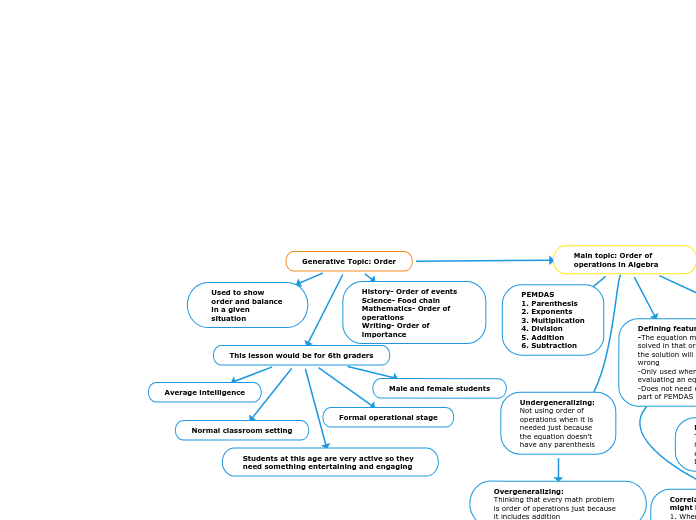Generative Topic: Order
History- Order of events Science- Food chain Mathematics- Order of operations Writing- Order of importance
Used to show order and balance in a given situation
This lesson would be for 6th graders
Average intelligence
Normal classroom setting
Male and female students
Formal operational stage
Students at this age are very active so they need something entertaining and engaging
Main topic: Order of operations in Algebra
PEMDAS
1. Parenthesis
2. Exponents
3. Multiplication
4. Division
5. Addition
6. Subtraction
Defining features:
-The equation must be solved in that order or the solution will be wrong
-Only used when evaluating an equation
-Does not need each part of PEMDAS
Correlational features that might lead to misconceptions:
1. When solving fractions with exponents, there are steps that must be taken first
2. When it is a problem of just addition and subtraction it doesn't matter the order
3. Multiplication and division have the same rule
Exemplars:
(4*23)+128-4*12
Order of Operations should be used to solve this. You would first do 4*23, then 4*12, then the parenthesis plus 128, then that answer minus the answer to 4*12.
Prototype: 120*4-30+4
This is a simple example of Order of Operations and it is easy to identify what needs to be solved first
Non-exemplars:
48*12*100*14
You do not need Order of Operations in this equation because no matter the order you solve it in, the answer will be the same.
Undergeneralizing:
Not using order of operations when it is needed just because the equation doesn't have any parenthesis
Overgeneralizing:
Thinking that every math problem is order of operations just because it includes addition
